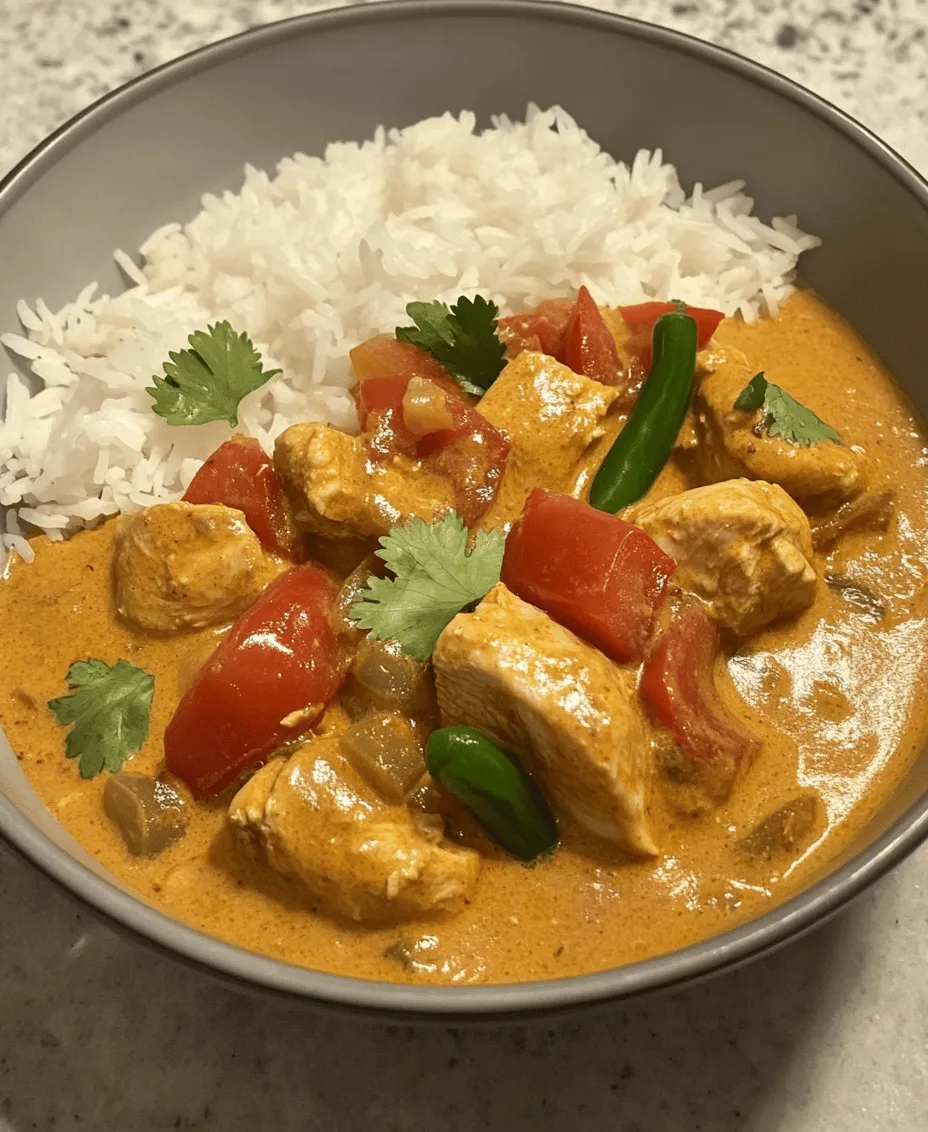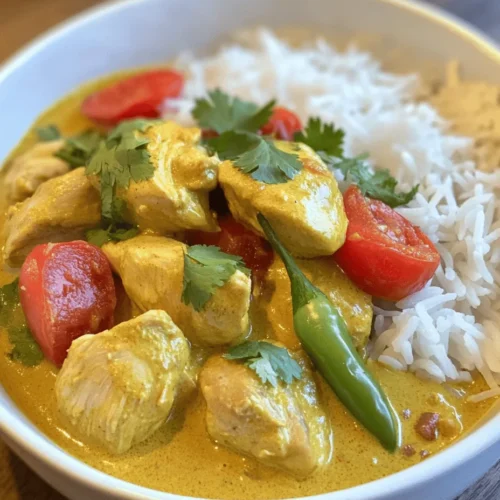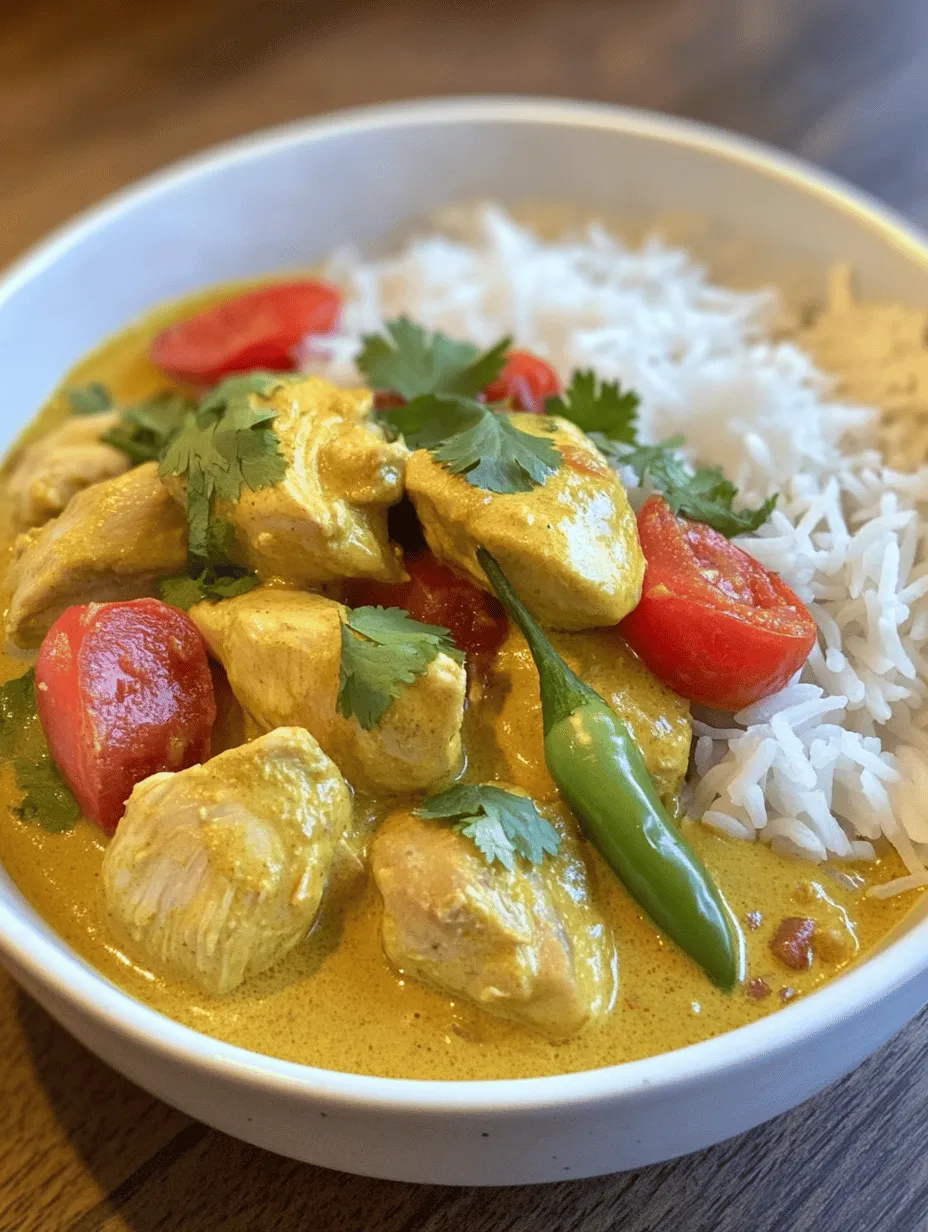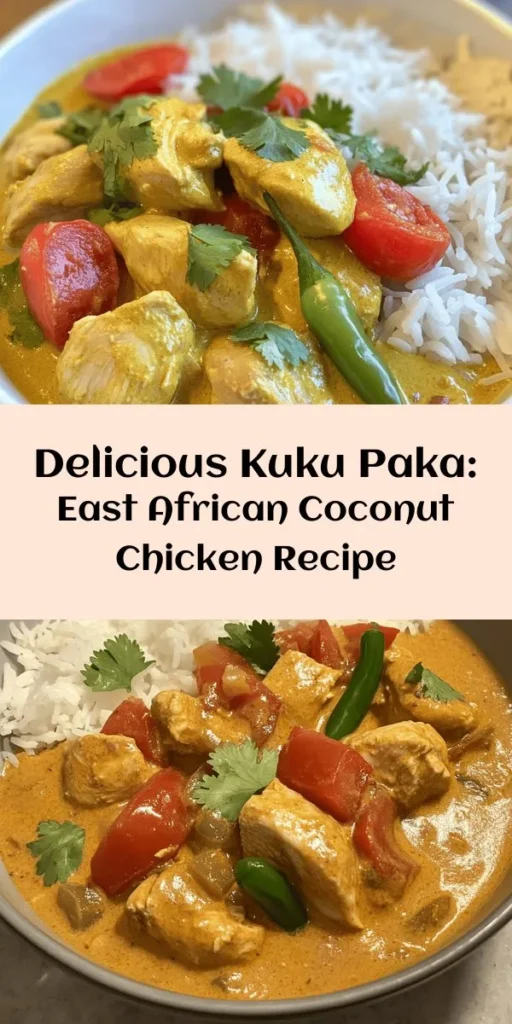Introduction
Kuku Paka, a traditional dish that hails from the coastal regions of East Africa, is a delightful representation of the rich culinary landscape that the area offers. This aromatic chicken curry, infused with the creamy goodness of coconut milk and a medley of spices, is not just a meal – it’s a celebration of culture and community. Often enjoyed during family gatherings and special occasions, Kuku Paka holds a significant place in the hearts and kitchens of those who have savored its unique flavors.
Coconut is a staple ingredient in East African cuisine, particularly in coastal countries like Kenya and Tanzania. Its versatility ranges from being an essential component in curries and stews to being used in desserts and snacks. Rich in flavor and nutrients, coconut milk brings a depth of creaminess to dishes while also providing a subtle sweetness that balances the spices used in cooking. In Kuku Paka, coconut milk not only enhances the flavor but also gives the dish a luscious texture that makes it irresistible.
This recipe for Kuku Paka is a fusion of flavors that marries the warmth of spices with the refreshing notes of coconut. It is simple to prepare, making it perfect for both novice cooks and seasoned chefs. With its vibrant colors and rich taste, Kuku Paka is sure to impress your family and friends, whether served on a casual weeknight or at a festive gathering.
Understanding Kuku Paka
The origins of Kuku Paka can be traced back to the Swahili coastal culture, where culinary traditions have been heavily influenced by the myriad of cultures that have settled along the East African coast, including Arab, Indian, and Portuguese. This rich history is reflected in the dish’s diverse ingredients and preparation methods, showcasing a blend of flavors that tell the story of the region’s heritage.
Regional variations of Kuku Paka abound, with each community adding its unique twist based on local ingredients and culinary practices. For example, in some variations, the dish might include additional vegetables or different spices, while others may opt for a spicier profile. This adaptability makes Kuku Paka a beloved dish that resonates with many, as it can be customized to suit individual tastes and dietary preferences.
Coconut milk plays a pivotal role in Kuku Paka, not only enhancing the dish’s flavor but also providing nutritional benefits. It is a rich source of medium-chain triglycerides (MCTs), which are known for their potential health benefits, including improved metabolism and energy levels. Additionally, the creaminess of coconut milk helps to mellow the heat from the spices, creating a perfect balance that is both comforting and satisfying.
Ingredients Breakdown
To create a delicious Kuku Paka, it’s essential to gather fresh, high-quality ingredients. Each component contributes to the overall flavor profile and nutritional value of the dish. Here’s a detailed breakdown of the key ingredients:
Chicken
The star of Kuku Paka is undoubtedly the chicken. For the best results, use fresh, quality cuts of chicken, such as thighs or breasts, as they provide the right balance of tenderness and flavor. Chicken thighs, in particular, are favored for their moistness and ability to absorb flavors during marination and cooking. When selecting chicken, look for organic or free-range options whenever possible, as they tend to have a better taste and texture.
Spices
Kuku Paka is characterized by its bold spice blend. Key spices include turmeric, salt, and black pepper. Turmeric not only gives the dish its vibrant golden color but also has anti-inflammatory properties, making it a healthful addition. Salt enhances the overall flavor, while black pepper adds a subtle kick. Together, these spices create a fragrant base that elevates the chicken and coconut milk, ensuring each bite is packed with flavor.
Aromatics
The role of aromatics in Kuku Paka cannot be overstated. Onions, garlic, and ginger form the flavor foundation of the dish. Onions provide sweetness and depth, while garlic adds a pungent aroma that complements the spices. Ginger, with its warm and slightly spicy notes, enhances the overall flavor complexity. Sautéing these aromatics until they are golden brown releases their essential oils, intensifying the dish’s flavor.
Coconut Milk
Coconut milk is the heart of Kuku Paka, lending a rich creaminess that envelops the chicken and spices. It not only enhances the flavor but also adds a velvety texture to the dish. Rich in healthy fats, coconut milk is also a source of vitamins C, E, and several B vitamins. Its natural sweetness balances the savory elements of the dish, making Kuku Paka a harmonious blend of flavors.
Tomatoes and Chilies
Fresh tomatoes and chilies are essential for providing acidity and heat to Kuku Paka. Tomatoes contribute a tangy flavor that brightens the dish, while the chilies introduce a spicy element that can be adjusted according to personal preference. The combination of these ingredients helps to round out the flavor profile, ensuring that Kuku Paka is both savory and vibrant.
Lemon Juice and Garam Masala
To finish off the dish, a splash of lemon juice adds a refreshing acidity that brightens the flavors. It cuts through the richness of the coconut milk and enhances the overall taste. Garam masala, a blend of ground spices commonly used in Indian cooking, adds a warm, aromatic finish to Kuku Paka. It can include spices such as cumin, coriander, and cardamom, each contributing to the dish’s complexity.
Fresh Coriander
Finally, fresh coriander (cilantro) serves as a garnish that adds a burst of color and freshness to the finished dish. Its bright flavor complements the richness of the coconut and the warmth of the spices, tying all the elements together beautifully. A sprinkle of coriander not only elevates the presentation but also enhances the overall taste.
Step-by-Step Cooking Instructions
Now that we have explored the ingredients that make Kuku Paka so special, it’s time to dive into the cooking process. The preparation of Kuku Paka involves several key steps, each crucial for developing the dish’s rich flavor.
Marinating the Chicken
The first step in creating a delicious Kuku Paka is marinating the chicken. This process is essential for allowing the spices to penetrate the meat, ensuring that each bite is flavorful. Begin by cutting the chicken into bite-sized pieces. In a mixing bowl, combine the chicken with turmeric, salt, and black pepper. Make sure to coat the chicken evenly with the spices.
Let the chicken marinate for at least 30 minutes, though longer is preferable. If time allows, marinating for a few hours or overnight will yield even more flavorful results. During this time, the acids from the spices help to tenderize the meat, making it juicier and more succulent.
Cooking the Onion Mixture
While the chicken is marinating, it’s time to prepare the aromatic base. Heat a few tablespoons of oil in a large skillet or pot over medium heat. Once the oil is hot, add finely chopped onions. Sauté the onions until they turn golden brown, stirring occasionally to avoid burning. This process typically takes about 8-10 minutes.
Perfectly sautéed onions are key to building a flavorful foundation for Kuku Paka. They contribute sweetness and depth to the dish, so take your time to achieve that golden color. If the onions start to stick to the pan, you can add a splash of water to loosen them up.
Adding Garlic, Ginger, and Chilies
Once the onions are beautifully caramelized, it’s time to introduce the garlic, ginger, and chilies. Add minced garlic and grated ginger to the pan, stirring them in with the onions. The timing is crucial here – these aromatics can burn quickly, so cook them for just 1-2 minutes until they become fragrant.
Next, add chopped fresh chilies according to your desired spice level. For a milder dish, you can deseed the chilies before chopping them. Stir the mixture well to combine all the flavors, allowing the heat from the chilies and the aroma from the garlic and ginger to infuse the onions.
With the ingredients prepared and the flavors developing, the Kuku Paka is well on its way to becoming a delicious meal that showcases the essence of East African cuisine. In the following sections, we will explore how to bring all the elements together to create this mouthwatering dish.

Incorporating Tomatoes: How to Cook Them Down for a Rich Base
The base of Kuku Paka is essential to achieving the dish’s signature flavor. Start by incorporating fresh tomatoes into your recipe. Choose ripe, juicy tomatoes for the best results. Begin by dicing about 2-3 medium-sized tomatoes, ensuring they are evenly cut for uniform cooking.
In your skillet, after browning the chicken, add the diced tomatoes to the pan. Allow them to simmer with the chicken for about 5-7 minutes. This process helps to cook the tomatoes down until they break apart, releasing their natural juices. Stir occasionally, ensuring they meld with the chicken and spices. The goal is to create a thick, rich sauce that will enhance the overall flavor of the dish.
Using a wooden spoon, you can gently mash the tomatoes as they cook, allowing them to integrate fully with the spices and chicken juices. This step is crucial as it forms the flavorful foundation for your coconut milk, ensuring that every bite of Kuku Paka is infused with a robust, tangy flavor.
Browning the Chicken: Techniques for Ensuring Even Cooking and Flavor Sealing
Browning the chicken is a vital step in preparing Kuku Paka. It not only enhances the flavor but also ensures that the chicken is cooked evenly. Start by heating a couple of tablespoons of oil in a large skillet over medium heat. Make sure the oil is hot before adding the chicken pieces.
Place the chicken in a single layer in the skillet, avoiding overcrowding, which can lead to steaming instead of browning. Sear the chicken for about 5-7 minutes on each side until golden brown. The key is to allow the chicken to develop a nice crust, which seals in the juices and adds depth to the dish.
Once browned, remove the chicken from the skillet and set it aside. This allows you to build layers of flavor in the same pan, as the remnants left from the browned chicken will infuse the sauce with a savory richness.
Adding Coconut Milk: Tips on Achieving the Right Consistency and Flavor Balance
Coconut milk is the star ingredient in Kuku Paka, providing a creamy texture and rich flavor. After you’ve built your tomato base and browned the chicken, it’s time to add the coconut milk. Pour in approximately one can (13.5 ounces) of full-fat coconut milk into the skillet with the chicken and tomato mixture.
When adding the coconut milk, stir gently to combine all the ingredients. Allow the mixture to simmer on low heat for about 20-25 minutes. This simmering process is crucial as it allows the flavors to meld beautifully.
To achieve the right consistency, you can adjust the thickness of your sauce by adding water or broth if it seems too thick. Conversely, if the sauce is too thin, let it simmer uncovered for a few more minutes to reduce and thicken. Taste continuously, as this is your opportunity to balance the flavors before serving.
Final Seasoning with Lemon Juice and Garam Masala: Importance of Taste Testing
As your Kuku Paka nears completion, the final seasoning touches are essential for a well-rounded flavor. Just before serving, squeeze in the juice of one fresh lemon. This adds a bright acidity that cuts through the richness of the coconut milk and balances the flavor profile.
Next, sprinkle in about a teaspoon of garam masala. This spice blend is key to enhancing the dish’s aromatic qualities. Stir the spices in well and allow them to integrate into the sauce for an additional 5 minutes. Always taste your dish at this stage. Adjust the seasoning as necessary, adding more salt or lemon juice according to your preference.
Tips for Garnishing and Serving: Suggestions for Pairing with Sides Like Rice or Ugali
When it comes to garnishing your Kuku Paka, fresh herbs can elevate the presentation and flavor. Chopped cilantro or parsley sprinkled on top right before serving adds a pop of color and freshness. You can also add thinly sliced green chilies for those who enjoy a bit of heat.
As for serving, Kuku Paka pairs beautifully with several traditional East African sides. Here are some popular accompaniments:
1. Rice: Both basmati and jasmine rice are excellent choices. Their fragrant qualities complement the coconut and spice flavors of the Kuku Paka. Cook the rice separately, following package instructions, and serve it fluffy alongside your chicken dish.
2. Chapati: This traditional flatbread is a staple in many East African meals. Its soft, chewy texture makes it perfect for scooping up the creamy sauce. To serve, warm the chapati in a skillet or microwave, and cut it into wedges for easy sharing.
3. Ugali: A staple food in East African diets, ugali is made from maize flour and water, forming a dense, dough-like consistency. It can be shaped into balls and served alongside Kuku Paka, allowing diners to enjoy the sauce by dipping the ugali into it.
4. Presentation Tips: For an appealing serving experience, consider using a large platter to present the Kuku Paka, surrounded by bowls of rice, chapati, and ugali. Use colorful garnishes like cilantro and sliced chilies to enhance the visual appeal. This communal style of serving encourages sharing and enhances the dining experience.
Nutritional Information
Kuku Paka is not only a delicious dish but also offers a variety of nutritional benefits, making it suitable for many diets. Here’s a brief overview of its nutritional value:
– Protein: The chicken provides a solid source of protein, essential for muscle growth and repair.
– Healthy Fats: Coconut milk adds healthy fats that are beneficial for heart health and provide energy.
– Vitamins and Minerals: Tomatoes contribute vitamins C and K, while various spices add antioxidants that boost overall health.
When considering dietary needs, Kuku Paka can be made gluten-free by ensuring that no wheat products are used in the preparation. The dish is naturally dairy-free, making it an excellent choice for those with lactose intolerance.
To balance your meal, consider serving it with healthy sides like a green salad or steamed vegetables. These additions will not only enhance the nutritional profile but also offer a contrasting texture and flavor to the creamy Kuku Paka.
Cultural Context and Significance
Kuku Paka holds a special place in East African cuisine, often featured in family gatherings, celebrations, and community feasts. The dish embodies the warmth and hospitality associated with East African culture, where sharing food is a way of fostering connections and building relationships.
Many families have their unique recipes passed down through generations, each adding personal touches that reflect their history and heritage. Whether it’s a festive gathering during Ramadan or a Sunday family meal, Kuku Paka brings people together around the table, celebrating the joy of food and togetherness.
Reflecting on personal experiences, many can recall the aroma of Kuku Paka wafting through the home during special occasions, drawing family and friends closer. This dish is more than just a meal; it represents love, community, and a shared cultural identity.
Conclusion
Kuku Paka is a delightful fusion of flavors that showcases the richness of East African cuisine. With its tender chicken, creamy coconut milk, and aromatic spices, this dish promises to be a hit at any dining table.
Exploring Kuku Paka is an invitation to connect with a vibrant culture and experience the culinary traditions of East Africa. As you prepare this dish, remember that cooking is not merely about nourishment; it is a way to preserve heritage and create lasting memories with loved ones.
As you embark on this culinary adventure, let Kuku Paka inspire you to delve deeper into East African cuisine and the stories that accompany every dish. Whether you’re preparing it for a special occasion or a cozy family dinner, this flavorful chicken delight is sure to impress and satisfy.



